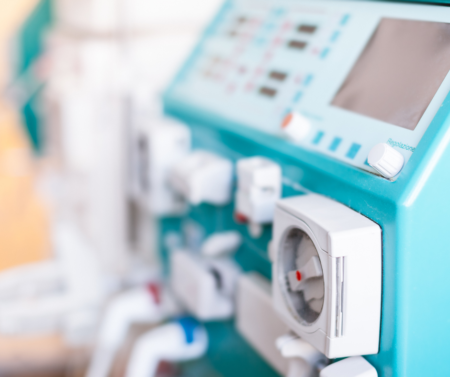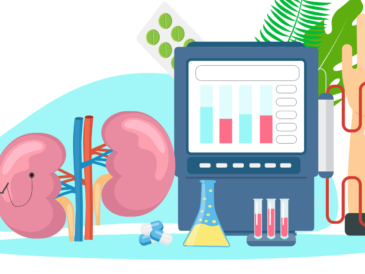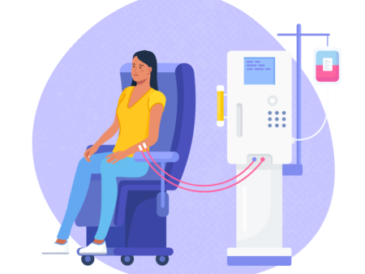Having muscle cramps during dialysis treatment doesn’t sound awful. Yet this is the reason why some patients quit dialysis. These cramps may be mild or excruciatingly painful, and they complicate about 33-86% of dialysis sessions.
But why does dialysis sometimes cause muscle cramps, and what can you do about them?
What causes muscle cramps?
Nobody knows what causes these cramps. But we know they can be painful and distressful. There are many plausible reasons why these cramps occur. The most popular explanation is that they result from excessive fluid removal. Experts believe this is why most episodes of dialysis-related muscle cramps occur towards the end of dialysis when most of the fluid has been removed.
But how exactly does excess fluid removal cause cramps?
When excess water is removed during dialysis, your blood pressure may fall and affect the oxygen supply to the muscles. With low oxygen tension in the muscle cells, cramps may follow.
Besides low oxygen levels, electrolyte disturbances most likely play a role. Low electrolytes like sodium, potassium, calcium and magnesium typically cause cramps in people. Experts believe shifts in these electrolytes may be responsible for muscle cramps during dialysis. For example, in one study, using a dialysate with low magnesium content was associated with more cramps compared with using dialysate with a higher magnesium content. This suggests the role of low magnesium levels.
Additionally, alkali is implicated in the development of cramps. The fluid used in dialysis contains bicarbonate, an alkali. And so, a patient may develop alkalosis (excess alkali) towards the end of dialysis, which may trigger muscle cramps.
Finally, a deficiency of carnitine, frequently seen in dialysis patients, is implicated in muscle cramping during dialysis treatment.
What do these muscle cramps feel like?
Muscle cramps during dialysis feel like sudden, painful twitches from muscle contractions. These contractions may be relatively brief or last for several seconds. Although they can occur in any part of the body, the legs are the most affected sites.

Risk factors for muscle cramps during dialysis
Gaining too much weight between your dialysis sessions puts you at risk for muscle cramps. This is because the weight you gain is mainly from fluids. So, when you gain too much weight between dialysis and your care team attempts to take out all the water, it may induce muscle cramps. So, it is important not to gain too much weight after dialysis.
Consuming too much salt is another risk factor for muscle cramps: Fluid retention accompanies salt. So, when you ingest lots of salt, you’ll also retain tons of fluid, contributing to weight gain between your dialysis sessions.
Poor urine output is yet another cause of cramps. Let’s suppose you’re making very little urine. In that case, it’s easy to gain more than 4kg between your dialysis sessions. This weight gain is particularly worse if you find it challenging to keep to the prescribed water restriction. The problem is that you’ll be keeping a considerable fraction of all the fluids you take in because you’re making little to no urine.
What can you do?
You can try to prevent muscle cramps from happening by keeping to the recommended fluid intake by your doctors. This is especially important if you have poor urine output. It would help if you also restricted your salt intake. Doing these things will help keep your weight under control so that your ultrafiltration during dialysis isn’t too high.
One other thing you can do to prevent muscle cramps during dialysis is to ensure you have regular dialysis as much as possible. When you wait too long between dialysis, you will accumulate much more fluid than usual.
If you develop symptoms during your dialysis treatment, Let your care team know. They will examine you and likely make some changes, including reducing the ultrafiltration or injecting you with normal saline.
Are there drugs for treating muscle cramps during dialysis?
There are some drugs your care team may try, but the evidence for their use is not robust. They include
- Quinine sulfate
- Carnitine
- Oxazepam
- Gabapentin
- Vitamin E and C
Complications of dialysis-related muscle cramps
Psychosocial problems: Many people find these cramps frustrating. They can make you anxious about dialysis and affect your sleep.
Adherence problems: People who feel scared of dialysis because of these cramps may delay having dialysis. The problem with postponing dialysis is that it increases the risk of having cramps during your subsequent dialysis. With persistent cramps, some people abandon dialysis altogether with the rapid accumulation of toxins in their bodies.
Summary
Muscle cramps are one of the complications of dialysis. Although they may be mild, they can also be frustratingly painful. You can lower your risk of having muscle cramps by lowering salt intake and restricting fluid intake appropriately. But if you develop cramps during your dialysis treatment, discuss them with your care team. They will explore several treatment options so you can continue with dialysis and get the life-saving benefits it offers.





1 Comment
[…] cramping is the most common and challenging complication of hemodialysis. During hemodialysis, muscular cramps occur almost 35-86% of the time. The most common causes of muscle cramping during hemodialysis […]